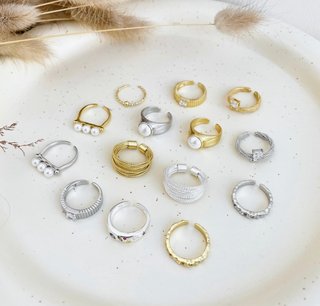Current Trends in Jewelry
Sustainable Jewelry: As environmental consciousness grows, sustainable and ethically sourced jewelry has become increasingly popular. Brands are utilizing recycled metals, conflict-free gemstones, and transparent sourcing practices to appeal to eco-conscious consumers.

Minimalist Designs: Simple, elegant pieces are in vogue. Minimalist jewelry emphasizes clean lines and subtle designs, which makes it versatile and timeless.
Personalized Pieces: Customizable jewelry, such as name necklaces, birthstone rings, and engraved bracelets, allows for a personal touch that makes each piece unique.
Vintage and Antique: Vintage and antique jewelry pieces are cherished for their history and craftsmanship. They feature a sense of nostalgia as well as design elements not commonly seen in modern pieces.
Bold Statement Pieces: Conversely, bold and oversized jewelry can also be trending. Chunky necklaces, large hoop earrings, and statement rings can also add a dramatic flair to any outfit.
Colored Gemstones: Beyond traditional diamonds, colored gemstones like sapphires, emeralds, and rubies are gaining popularity for their vibrant hues and unique appeal.
Methods for Buying Jewelry
Set a financial budget: Determine how much you're prepared to spend before you start shopping. This helps narrow down options and prevents overspending.
Research and Educate: View the basics of jewellery, including different types of metals, gemstones, and settings. Information about the 4Cs of diamonds (cut, color, clarity, and carat) is specially useful if you are buying diamond jewelry.
Choose Reputable Retailers: Obtain reputable jewelers who provide certificates of authenticity and provide return policies. Look for reviews and ratings to make certain credibility.
Inspect Quality: Examine the craftsmanship with the piece. Look into the prongs, clasps, and overall finish. Ensure gemstones are securely set and metals are of high quality.
Understand Warranties and Policies: Be familiar with the store's return policy, warranties, and services like resizing and cleaning. This may save you hassle and additional costs down the road.
Consider Timelessness: While trends are appealing, consider pieces which will remain stylish as time passes. Timeless designs can offer lasting value and flexibility.
Customization Options: Many jewelers offer customization services. Personalized jewelry can also add sentimental value and make sure the piece matches your specific taste.
Insurance: For valuable pieces, a great idea is insurance. This provides peace of mind in the event of loss, theft, or damage.
Important Considerations
Metal Types: Common metals include gold, silver, platinum, and titanium. Each has its own properties and value points. Gold will come in various purities (karats), and silver can tarnish over time without proper care.
Gemstone Quality: If purchasing gemstones, consider factors such as natural vs. lab-created stones. Lab-created stones are often more affordable and also have fewer imperfections.
Ethical Sourcing: Guarantee the jewelry is sourced ethically. Conflict-free diamonds and fair-trade gemstones are increasingly important to many buyers.
Resale Value: Some jewelry retains timid player than others. Gold, platinum, and high-quality diamonds routinely have good resale value.
Occasion and Purpose: The purpose of the purchase can influence your choice. Diamond engagement rings, anniversary gifts, or everyday wear pieces might require different considerations.
Trends vs. Classics: Balance trendy pieces with classic designs. Trendy jewelry can be fun but can not remain in style, while classic pieces offer long-term appeal.
Buying jewelry can be a personal and quite often emotional experience. Whether you’re selecting a piece for a special occasion or contributing to your collection, understanding current trends, quality indicators, along with your own preferences will make the process more fulfilling and successful. By considering these tips and considerations, you can make informed decisions and discover pieces which will bring joy and cost for years to come.